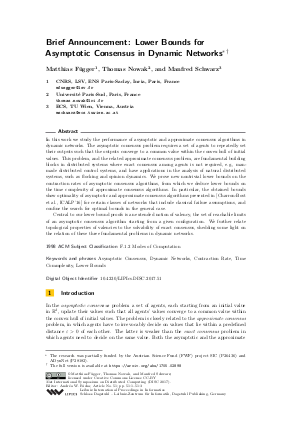Brief Announcement: Lower Bounds for Asymptotic Consensus in Dynamic Networks
Authors Matthias Függer, Thomas Nowak, Manfred Schwarz
-
Part of:
Volume:
31st International Symposium on Distributed Computing (DISC 2017)
Part of: Series: Leibniz International Proceedings in Informatics (LIPIcs)
Part of: Conference: International Symposium on Distributed Computing (DISC) - License:
 Creative Commons Attribution 3.0 Unported license
Creative Commons Attribution 3.0 Unported license
- Publication Date: 2017-10-12
File

PDF
LIPIcs.DISC.2017.51.pdf
- Filesize: 406 kB
- 3 pages
Document Identifiers
Subject Classification
Keywords
- Asymptotic Consensus
- Dynamic Networks
- Contraction Rate
- Time Commplexity
- Lower Bounds
Metrics
- Access Statistics
-
Total Accesses (updated on a weekly basis)
0Document
0Metadata
Abstract
In this work we study the performance of asymptotic and approximate consensus algorithms in dynamic networks. The asymptotic consensus problem requires a set of agents to repeatedly set their outputs such that the outputs converge to a common value within the convex hull of initial values. This problem, and the related approximate consensus problem, are fundamental building blocks in distributed systems where exact consensus among agents is not required, e.g., man-made distributed control systems, and have applications in the analysis of natural distributed systems, such as flocking and opinion dynamics. We prove new nontrivial lower bounds on the contraction rates of asymptotic consensus algorithms, from which we deduce lower bounds on the time complexity of approximate consensus algorithms. In particular, the obtained bounds show optimality of asymptotic and approximate consensus algorithms presented in [Charron-Bost et al., ICALP'16] for certain classes of networks that include classical failure assumptions, and confine the search for optimal bounds in the general case. Central to our lower bound proofs is an extended notion of valency, the set of reachable limits of an asymptotic consensus algorithm starting from a given configuration. We further relate topological properties of valencies to the solvability of exact consensus, shedding some light on the relation of these three fundamental problems in dynamic networks.
Cite As Get BibTex
Matthias Függer, Thomas Nowak, and Manfred Schwarz. Brief Announcement: Lower Bounds for Asymptotic Consensus in Dynamic Networks. In 31st International Symposium on Distributed Computing (DISC 2017). Leibniz International Proceedings in Informatics (LIPIcs), Volume 91, pp. 51:1-51:3, Schloss Dagstuhl – Leibniz-Zentrum für Informatik (2017)
https://doi.org/10.4230/LIPIcs.DISC.2017.51
BibTex
@InProceedings{fugger_et_al:LIPIcs.DISC.2017.51,
author = {F\"{u}gger, Matthias and Nowak, Thomas and Schwarz, Manfred},
title = {{Brief Announcement: Lower Bounds for Asymptotic Consensus in Dynamic Networks}},
booktitle = {31st International Symposium on Distributed Computing (DISC 2017)},
pages = {51:1--51:3},
series = {Leibniz International Proceedings in Informatics (LIPIcs)},
ISBN = {978-3-95977-053-8},
ISSN = {1868-8969},
year = {2017},
volume = {91},
editor = {Richa, Andr\'{e}a},
publisher = {Schloss Dagstuhl -- Leibniz-Zentrum f{\"u}r Informatik},
address = {Dagstuhl, Germany},
URL = {https://drops.dagstuhl.de/entities/document/10.4230/LIPIcs.DISC.2017.51},
URN = {urn:nbn:de:0030-drops-79921},
doi = {10.4230/LIPIcs.DISC.2017.51},
annote = {Keywords: Asymptotic Consensus, Dynamic Networks, Contraction Rate, Time Commplexity, Lower Bounds}
}
Author Details
References
-
J. A. Benediktsson and P. H. Swain. Consensus theoretic classification methods. IEEE Transactions on Systems, Man, and Cybernetics, 22(4):688-704, 1992.

-
Bernadette Charron-Bost, Matthias Függer, and Thomas Nowak. Approximate consensus in highly dynamic networks: The role of averaging algorithms. In Proceedings of ICALP, pages 528-539, 2015.

-
Bernadette Charron-Bost, Matthias Függer, and Thomas Nowak. Fast, robust, quantizable approximate consensus. In Proceedings of the 43rd International Colloquium on Automata, Languages, and Programming, ICALP16, pages 137:1-137:14, 2016.

-
Bernadette Charron-Bost, Matthias Függer, and Thomas Nowak. Multidimensional asymptotic consensus in dynamic networks. CoRR, abs/1611.02496, 2016.

-
George Cybenko. Dynamic load balancing for distributed memory multiprocessors. Journal of Parallel and Distributed Computing, 7(2):279-301, 1989.

-
Magnus Egerstedt and Xiaoming Hu. Formation constrained multi-agent control. IEEE Transactions on Robotics and Automation, 17(6):947-951, 2001.

-
R. Hegselmann and U. Krause. Opinion dynamics and bounded confidence models, analysis, and simulation. Journal of artificial societies and social simulation, 5(3):1-33, 2002.

-
Qun Li and Daniela Rus. Global clock synchronization in sensor networks. IEEE Transactions on Computers, 55(2):214-226, 2006.

-
J. Lin, A.S. Morse, and B.D.O. Anderson. The multi-agent rendezvous problem. In Vijay Kumar, Naomi Leonard, and A. Stephen Morse, editors, Cooperative Control: A Post-Workshop Volume 2003 Block Island Workshop on Cooperative Control, pages 257-289. Springer, Heidelberg, 2005.

-
Renato E. Mirollo and Steven H. Strogatz. Synchronization of pulse-coupled biological oscillators. SIAM Journal on Applied Mathematics, 50(6):1645-1662, December 1990.

-
Tamás Vicsek, András Czirók, Eshel Ben-Jacob, Inon Cohen, and Ofer Shochet. Novel type of phase transition in a system of self-driven particles. Physical Review Letters, 75(6):1226-1229, 1995.

